Estimation of PM2.5 Concentration Efficiency and Potential Public Mortality Reduction in Urban China
Abstract
:1. Introduction
2. Data and Methods
2.1. Observed Regions and Data Source
2.2. Methods
2.2.1. Particulate Matter 2.5 Concentration Efficiency Estimation
2.2.2. Particulate Matter 2.5 Concentration Efficiency Estimation from Overall and Environmental Perspectives
2.2.3. Potential Public Mortality Reductions
3. Results
3.1. The Particulate Matter 2.5 2.5 Concentration Efficiency and Potential Mortality Reduction for Different Areas of China
3.2. The Particulate Matter 2.52.5 Concentration Efficiency and Potential Mortality Reduction for China’s Cities
4. Discussion
5. Conclusions
Supplementary Materials
Acknowledgments
Author Contributions
Conflicts of Interest
References
- Zhang, Q.; Crooks, R. Toward an Environmentally Sustainable Future: Country Environmental Analysis of the People's Republic of China; Asian Development Bank: Mandaluyong City, Philippines, 2012; pp. 55–56. ISBN 978-92-9092-713-6. [Google Scholar]
- Yang, G.; Huang, J.; Li, X. Mining sequential patterns of PM2.5 pollution in three zones in china. J. Clean Prod. 2018, 170, 388–398. [Google Scholar] [CrossRef]
- Han, R.; Wang, S.X.; Shen, W.H.; Wang, J.D.; Wu, K.; Ren, Z.H.; Feng, M.N. Spatial and temporal variation of haze in china from 1961 to 2012. J. Environ. Sci. 2016, 46, 134–146. [Google Scholar] [CrossRef] [PubMed]
- Xu, B.; Lin, B. What cause large regional differences in pm2.5 pollutions in china? Evidence from quantile regression model. J. Clean Prod. 2018, 174, 447–461. [Google Scholar] [CrossRef]
- Lelieveld, J.; Evans, J.S.; Fnais, M.; Giannadaki, D.; Pozzer, A. The contribution of outdoor air pollution sources to premature mortality on a global scale. Nature 2015, 525, 367–371. [Google Scholar] [CrossRef] [PubMed]
- Brunt, H.; Barnes, J.; Longhurst, J.W.S.; Scally, G.; Hayes, E. Enhancing local air quality management to maximise public health integration, collaboration and impact in Wales, UK: A Delphi study. Environ. Sci. Policy 2018, 80, 105–116. [Google Scholar] [CrossRef]
- Liu, T.; Cai, Y.; Feng, B.; Cao, G.; Lin, H.; Xiao, J.; Li, X.; Liu, S.; Pei, L.; Fu, L.; et al. Long-term mortality benefits of air quality improvement during the twelfth five-year-plan period in 31 provincial capital cities of china. Atmos. Environ. 2018, 173, 53–61. [Google Scholar] [CrossRef]
- World Health Organization. Burden of Disease from the Joint Effects of Household and Ambient Air Pollution for 2012. Available online: http://www.who.int/phe/health_topics/outdoorair/databases/FINAL_HAP_AAP_BoD_24March2014.pdf?ua=1 (accessed on 10 February 2018).
- Fu, H.; Chen, J. Formation, features and controlling strategies of severe haze-fog pollutions in China. Sci. Total Environ. 2017, 578, 121–138. [Google Scholar] [CrossRef] [PubMed]
- Liu, J.; Han, Y.Q.; Tang, X.; Zhu, J.; Zhu, T. Estimating adult mortality attributable to PM2.5 exposure in china with assimilated PM2.5 concentrations based on a ground monitoring network. Sci. Total Environ. 2016, 568, 1253–1262. [Google Scholar] [CrossRef] [PubMed]
- Lee, M.; Zhang, N. Technical efficiency, shadow price of carbon dioxide emissions, and substitutability for energy in the Chinese manufacturing industries. Energy Econ. 2012, 34, 1492–1497. [Google Scholar] [CrossRef]
- Wu, X.; Chen, Y.; Guo, J.; Gao, G. Inputs optimization to reduce the undesirable outputs by environmental hazards: A DEA model with data of PM2.5 in China. Nat. Hazards 2018, 90, 1–25. [Google Scholar] [CrossRef]
- Cheng, Z.H.; Li, L.S.; Liu, J. Identifying the spatial effects and driving factors of urban PM2.5 pollution in China. Ecol. Indic. 2017, 82, 61–75. [Google Scholar] [CrossRef]
- Shi, H.; Fan, J.; Zhao, D. Predicting household PM2.5-reduction behavior in Chinese urban areas: An integrative model of theory of planned behavior and norm activation theory. J. Clean Prod. 2017, 145, 64–73. [Google Scholar] [CrossRef]
- Zhou, C.; Chen, J.; Wang, S. Examining the effects of socioeconomic development on fine particulate matter (PM2.5) in China’s cities using spatial regression and the geographical detector technique. Sci. Total Environ. 2018, 619–620, 436–445. [Google Scholar] [CrossRef] [PubMed]
- Cai, S.; Wang, Y.; Zhao, B.; Wang, S.; Chang, X.; Hao, J. The impact of the “air pollution prevention and control action plan” on PM2.5 concentrations in Jing-Jin-Ji region during 2012–2020. Sci. Total Environ. 2017, 580, 197–209. [Google Scholar] [CrossRef] [PubMed]
- Cooper, W.W.; Seiford, L.M.; Zhu, J. Handbook on Data Envelopment Analysis; Springer: New York, NY, USA, 2011; ISBN 978-1-4419-6150-1. [Google Scholar]
- Wei, Y.M.; Liao, H.; Fan, Y. An empirical analysis of energy efficiency in China’s iron and steel sector. Energy 2007, 32, 2262–2270. [Google Scholar] [CrossRef]
- Zhou, Z.; Liu, C.; Zeng, X.; Jiang, Y.; Liu, W. Carbon emission performance evaluation and allocation in Chinese cities. J. Clean Prod. 2018, 172, 1254–1272. [Google Scholar] [CrossRef]
- Coli, M.; Nissi, E.; Rapposelli, A. Monitoring environmental efficiency: An application to Italian provinces. Environ. Model. Softw. 2011, 26, 38–43. [Google Scholar] [CrossRef]
- Bian, Y.; Yang, F. Resource and environment efficiency analysis of provinces in china: A DEA approach based on Shannon’s entropy. Energy Policy 2010, 38, 1909–1917. [Google Scholar] [CrossRef]
- Ramli, N.A.; Munisamy, S. Eco-efficiency in greenhouse emissions among manufacturing industries: A range adjusted measure. Econ. Model. 2015, 47, 219–227. [Google Scholar] [CrossRef]
- Valadkhani, A.; Roshdi, I.; Smyth, R. A multiplicative environmental DEA approach to measure efficiency changes in the world’s major polluters. Energy Econ. 2016, 54, 363–375. [Google Scholar] [CrossRef]
- Halkos, G.E.; Tzeremes, N.G. Exploring the existence of Kuznets curve in countries’ environmental efficiency using DEA window analysis. Ecol. Econ. 2009, 68, 2168–2176. [Google Scholar] [CrossRef] [Green Version]
- Song, M.L.; Wang, S.H. DEA decomposition of China’s environmental efficiency based on search algorithm. Appl. Math. Comput. 2014, 247, 562–572. [Google Scholar] [CrossRef]
- Chang, Y.T.; Zhang, N.; Danao, D.; Zhang, N. Environmental efficiency analysis of transportation system in China: A non-radial DEA approach. Energy Policy 2013, 58, 277–283. [Google Scholar] [CrossRef]
- Chen, L.; Jia, G.Z. Environmental efficiency analysis of China’s regional industry: A data envelopment analysis (DEA) based approach. J. Clean Prod. 2017, 142, 846–853. [Google Scholar] [CrossRef]
- Yang, H.L.; Pollitt, M. Incorporating both undesirable outputs and uncontrollable variables into DEA: The performance of Chinese coal-fired power plants. Eur. J. Oper. Res. 2009, 197, 1095–1105. [Google Scholar] [CrossRef]
- Wu, X.; Tan, L.; Guo, J.; Wang, Y.; Liu, H.; Zhu, W. A study of allocative efficiency of PM2.5 emission rights based on a zero sum gains data envelopment model. J. Clean Prod. 2016, 113, 1024–1031. [Google Scholar] [CrossRef]
- Chen, N.C.; Xu, L.; Chen, Z.Q. Environmental efficiency analysis of the Yangtze River Economic Zone using super efficiency data envelopment analysis (SEDEA) and tobit models. Energy 2017, 134, 659–671. [Google Scholar] [CrossRef]
- Xie, B.C.; Duan, N.; Wang, Y.S. Environmental efficiency and abatement cost of China’s industrial sectors based on a three-stage data envelopment analysis. J. Clean Prod. 2017, 153, 626–636. [Google Scholar] [CrossRef]
- Sueyoshi, T.; Yuan, Y. Marginal rate of transformation and rate of substitution measured by DEA environmental assessment: Comparison among European and North American nations. Energy Econ. 2016, 56, 270–287. [Google Scholar] [CrossRef]
- Zhao, T.; Yang, Z. Towards green growth and management: Relative efficiency and gaps of Chinese cities. Renew. Sustain. Energy Rev. 2017, 80, 481–494. [Google Scholar] [CrossRef]
- Jin, Q.; Fang, X.; Wen, B.; Shan, A. Spatio-temporal variations of PM2.5 emission in China from 2005 to 2014. Chemosphere 2017, 183, 429–436. [Google Scholar] [CrossRef] [PubMed]
- Liu, Z.J.; Li, H.; Cao, G.Q. Quick estimation model for the concentration of indoor airborne culturable bacteria: An application of machine learning. Int. J. Environ. Res. Public Health 2017, 14, 857. [Google Scholar] [CrossRef] [PubMed]
- Liu, Z.J.; Zhu, Z.Q.; Zhu, Y.X.; Xu, W.; Li, H. Investigation of dust loading and culturable microorganisms of hvac systems in 24 office buildings in Beijing. Energy Build. 2015, 103, 166–174. [Google Scholar] [CrossRef]
- Maji, K.J.; Dikshit, A.K.; Arora, M.; Deshpande, A. Estimating premature mortality attributable to PM2.5 exposure and benefit of air pollution control policies in China for 2020. Sci. Total Environ. 2018, 612, 683–693. [Google Scholar] [CrossRef] [PubMed]
- Feng, L.; Ye, B.; Feng, H.; Ren, F.; Huang, S.; Zhang, X.; Zhang, Y.; Du, Q.; Ma, L. Spatiotemporal changes in fine particulate matter pollution and the associated mortality burden in China between 2015 and 2016. Int. J. Environ. Res. Public Health 2017, 14, 1321. [Google Scholar] [CrossRef] [PubMed]
- Hu, J.L.; Wang, S.C. Total-factor energy efficiency of regions in china. Energy Policy 2006, 34, 3206–3217. [Google Scholar] [CrossRef]
- Du, J.; Chen, Y.; Huang, Y. A modified Malmquist-luenberger productivity index: Assessing environmental productivity performance in China. Eur. J. Oper. Res. 2017. [Google Scholar] [CrossRef]
- Wang, J.; Lv, K.J.; Bian, Y.W.; Cheng, Y. Energy efficiency and marginal carbon dioxide emission abatement cost in urban China. Energy Policy 2017, 105, 246–255. [Google Scholar] [CrossRef]
- Liu, C.Q.; Li, L.; Wei, P. Measuring on China’s urban capital stock at prefecture-level and higher level. Urban Probl. 2017, 67–72. (In Chinese) [Google Scholar] [CrossRef]
- Xu, S. An estimation of the capital stock and technological progress rates in Chinese cities: 1992~2014. Manag. World 2017, 17–29. (In Chinese) [Google Scholar] [CrossRef]
- PM2.5 Science Experiment Expert Group. Online Monitoring and Analysis Platform for the Air Quality in China. Available online: https://www.aqistudy.cn/historydata/ (accessed on 11 February 2018).
- Hao, Y.; Peng, H.; Temulun, T.; Liu, L.Q.; Mao, J.; Lu, Z.N.; Chen, H. How harmful is air pollution to economic development? New evidence from PM2.5 concentrations of Chinese cities. J. Clean Prod. 2018, 172, 743–757. [Google Scholar] [CrossRef]
- Tone, K. A slacks-based measure of efficiency in data envelopment analysis. Eur. J. Oper. Res. 2001, 130, 498–509. [Google Scholar] [CrossRef]
- Wang, K.; Wei, Y.M.; Huang, Z.M. Potential gains from carbon emissions trading in China: A DEA based estimation on abatement cost savings. Omega-Int. J. Manag. Sci. 2016, 63, 48–59. [Google Scholar] [CrossRef]
- Bian, Y.W.; Lv, K.J.; Yu, A.Y. China’s regional energy and carbon dioxide emissions efficiency evaluation with the presence of recovery energy: An interval slacks-based measure approach. Ann. Oper. Res. 2017, 255, 301–321. [Google Scholar] [CrossRef]
- Burnett, R.T.; Pope, C.A., III; Ezzati, M.; Olives, C.; Lim, S.S>; Mehta, S.; Shin, H.H.; Singh, G.; Hubbell, B.; Brauer, M. An integrated risk function for estimating the global burden of disease attributable to ambient fine particulate matter exposure. Environ. Health Perspect. 2014, 122, 397. [Google Scholar] [CrossRef] [PubMed]
- Apte, J.S.; Marshall, J.D.; Cohen, A.J.; Brauer, M. Addressing global mortality from ambient PM2.5. Environ. Sci. Technol. 2015, 49, 8057–8066. [Google Scholar] [CrossRef] [PubMed]
- Jiang, X.; Hong, C.; Zheng, Y.; Zheng, B.; Guan, D.; Gouldson, A.; Zhang, Q.; He, K. To what extent can China’s near-term air pollution control policy protect air quality and human health? A case study of the Pearl River Delta Region. Environ. Res. Lett. 2015, 10, 1–13. [Google Scholar] [CrossRef]
- IHME. Global Burden of Disease Study 2010 (GBD 2010)—Ambient Air Pollution Risk Model 1990–2010. Available online: http://ghdx.healthdata.org/record/global-burden-disease-study-2010-gbd-2010-ambient-air-pollution-risk-model-1990-2010 (accessed on 10 February 2018).
- Li, G.; Xue, M.; Zeng, Q.; Cai, Y.; Pan, X.; Meng, Q. Association between fine ambient particulate matter and daily total mortality: An analysis from 160 communities of china. Sci. Total Environ. 2017, 599, 108–113. [Google Scholar] [CrossRef] [PubMed]
- Chen, H.; Lin, Y.; Su, Q.; Cheng, L.Q. Spatial variation of multiple air pollutants and their potential contributions to all-cause, respiratory, and cardiovascular mortality across China in 2015-2016. Atmos. Environ. 2017, 168, 23–35. [Google Scholar] [CrossRef]
- Cheng, Z.; Chen, L.J.; Li, H.H.; Lin, J.Q.; Yang, Z.B.; Yang, Y.X.; Xu, X.X.; Xian, J.R.; Shao, J.R.; Zhu, X.M. Characteristics and health risk assessment of heavy metals exposure via household dust from urban area in Chengdu, China. Sci. Total Environ. 2018, 619, 621–629. [Google Scholar] [CrossRef] [PubMed]
- Liu, Z.J.; Cheng, K.W.; Li, H.; Cao, G.Q.; Wu, D.; Shi, Y.J. Exploring the potential relationship between indoor air quality and the concentration of airborne culturable fungi: A combined experimental and neural network modeling study. Environ. Sci. Pollut. Res. 2018, 25, 3510–3517. [Google Scholar] [CrossRef] [PubMed]

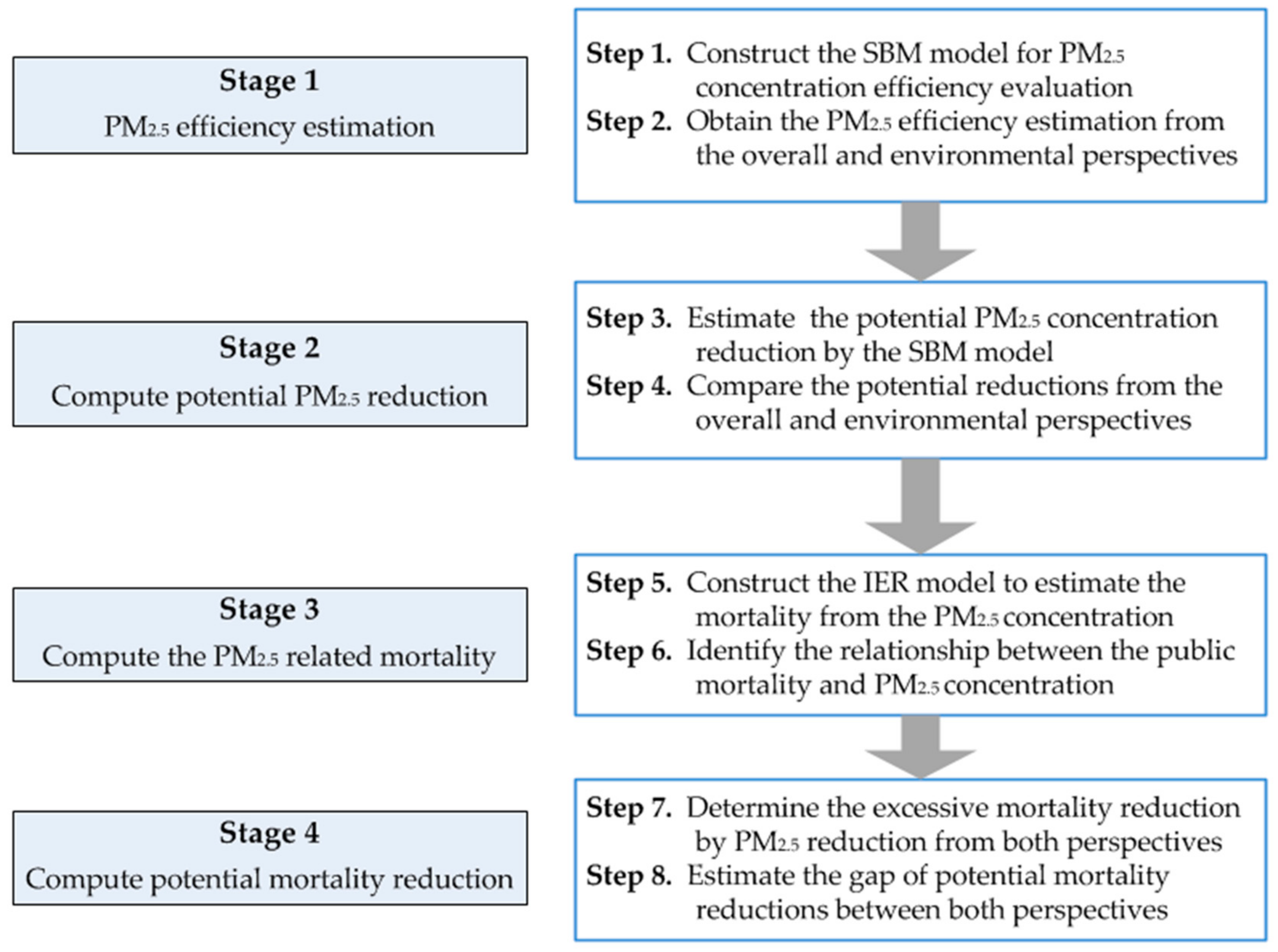
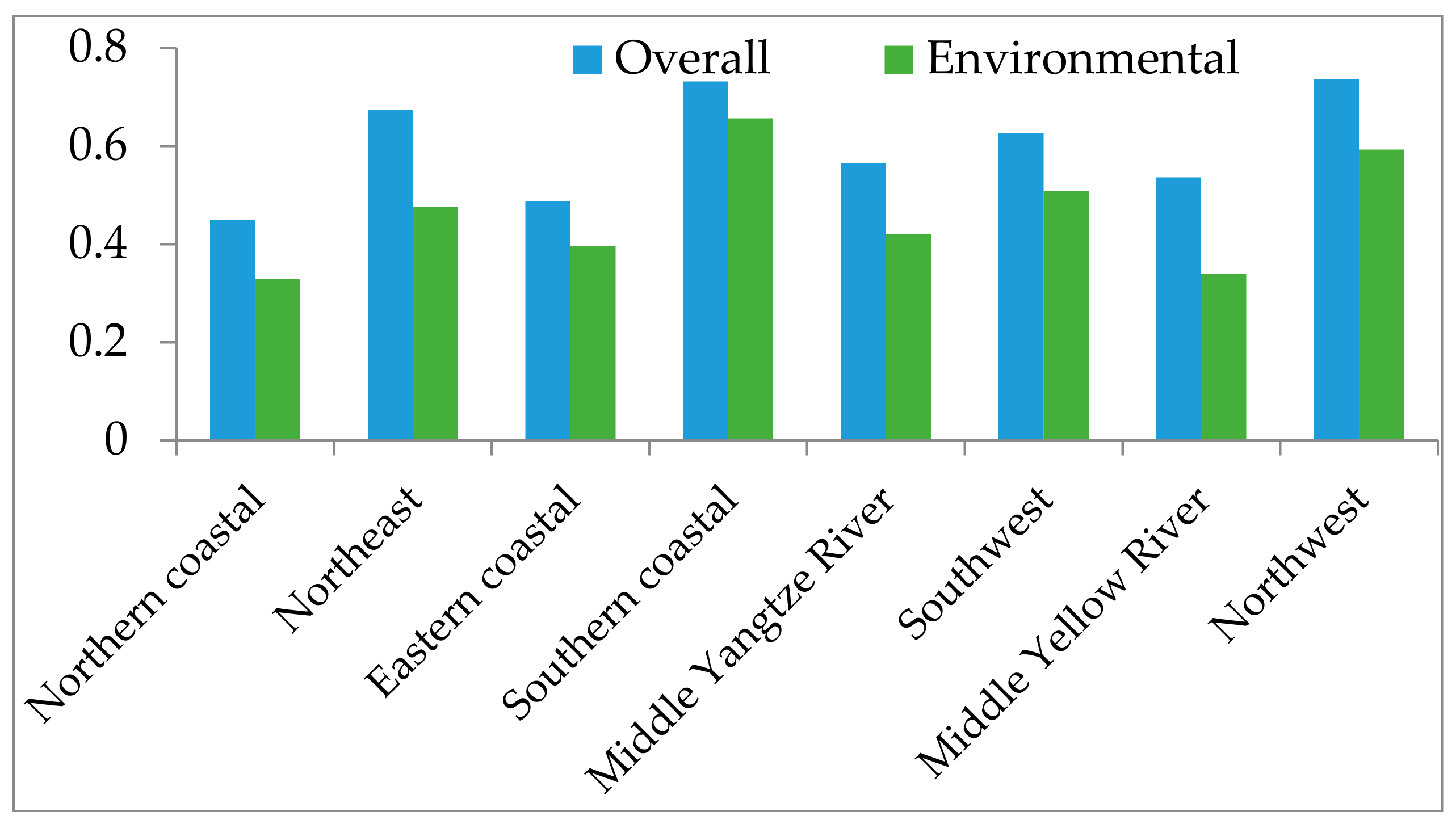
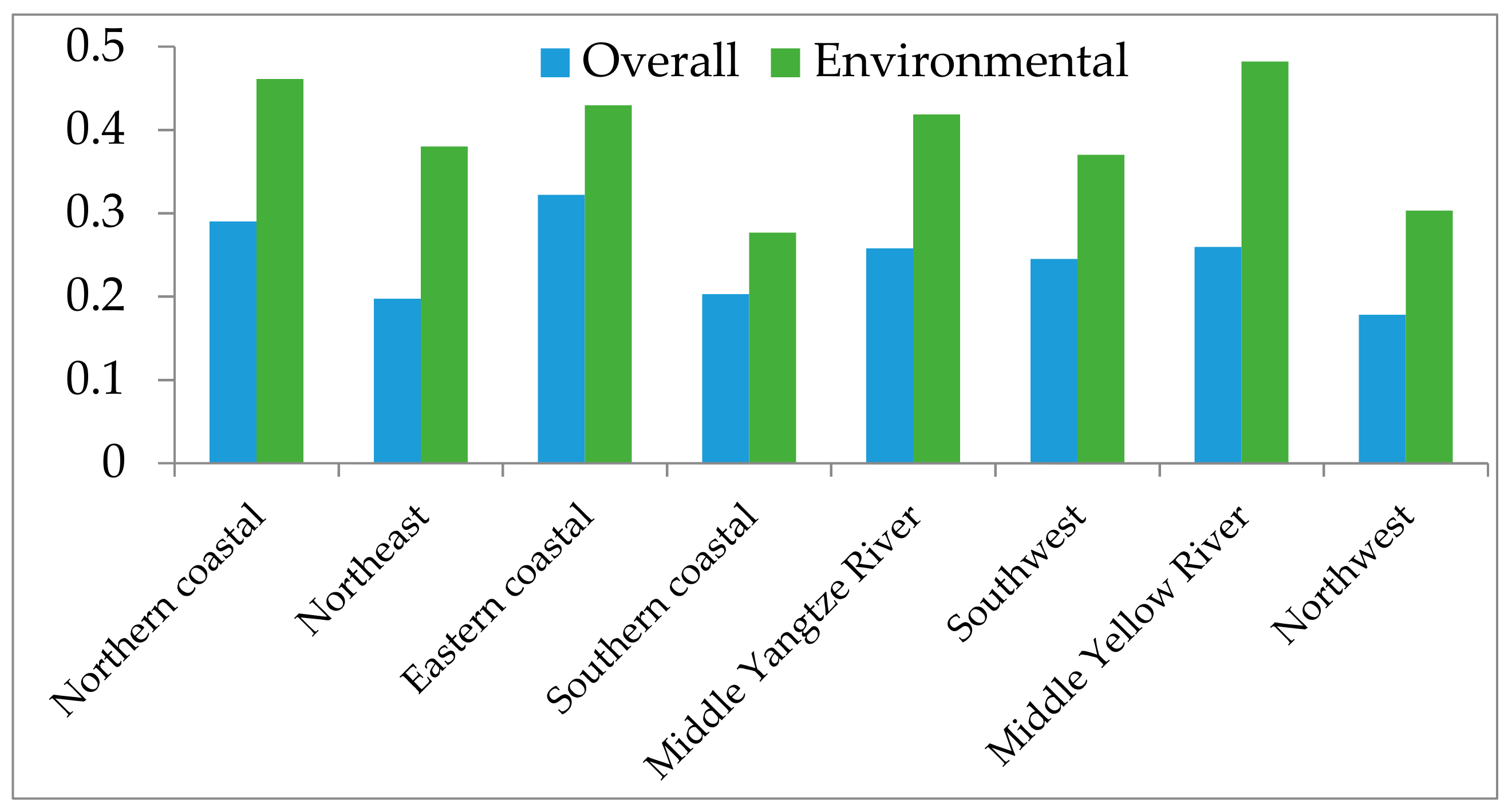
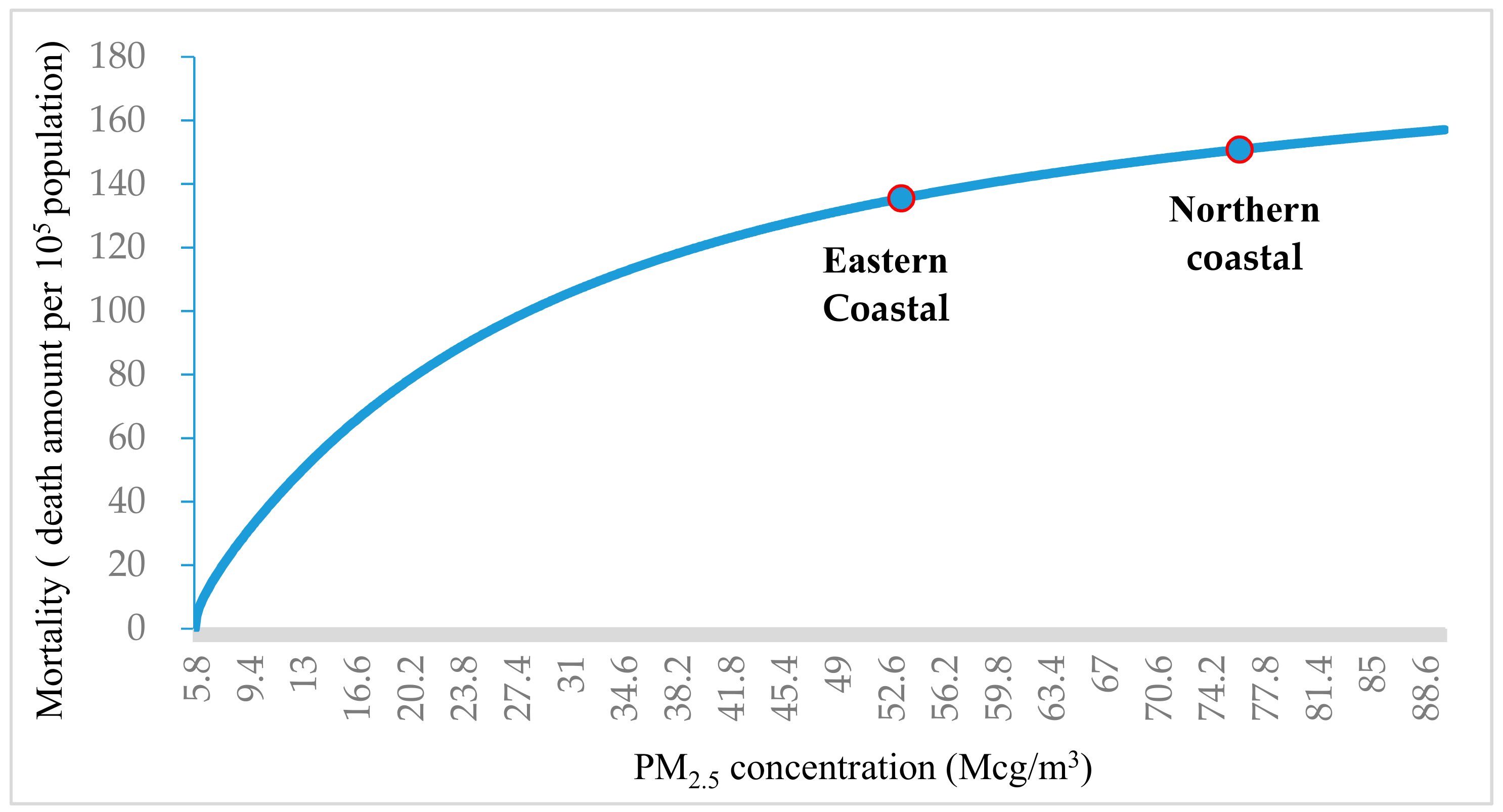

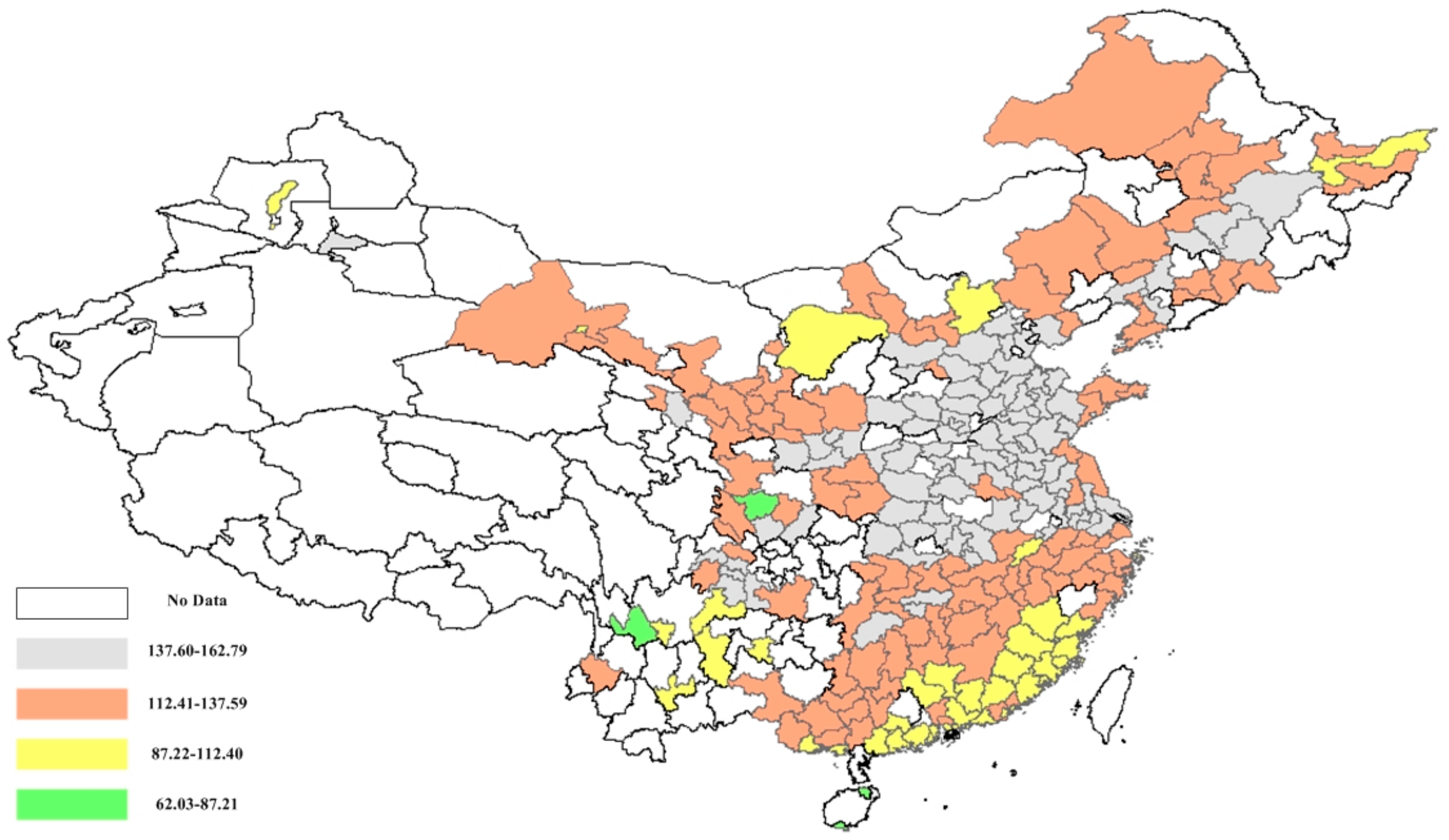

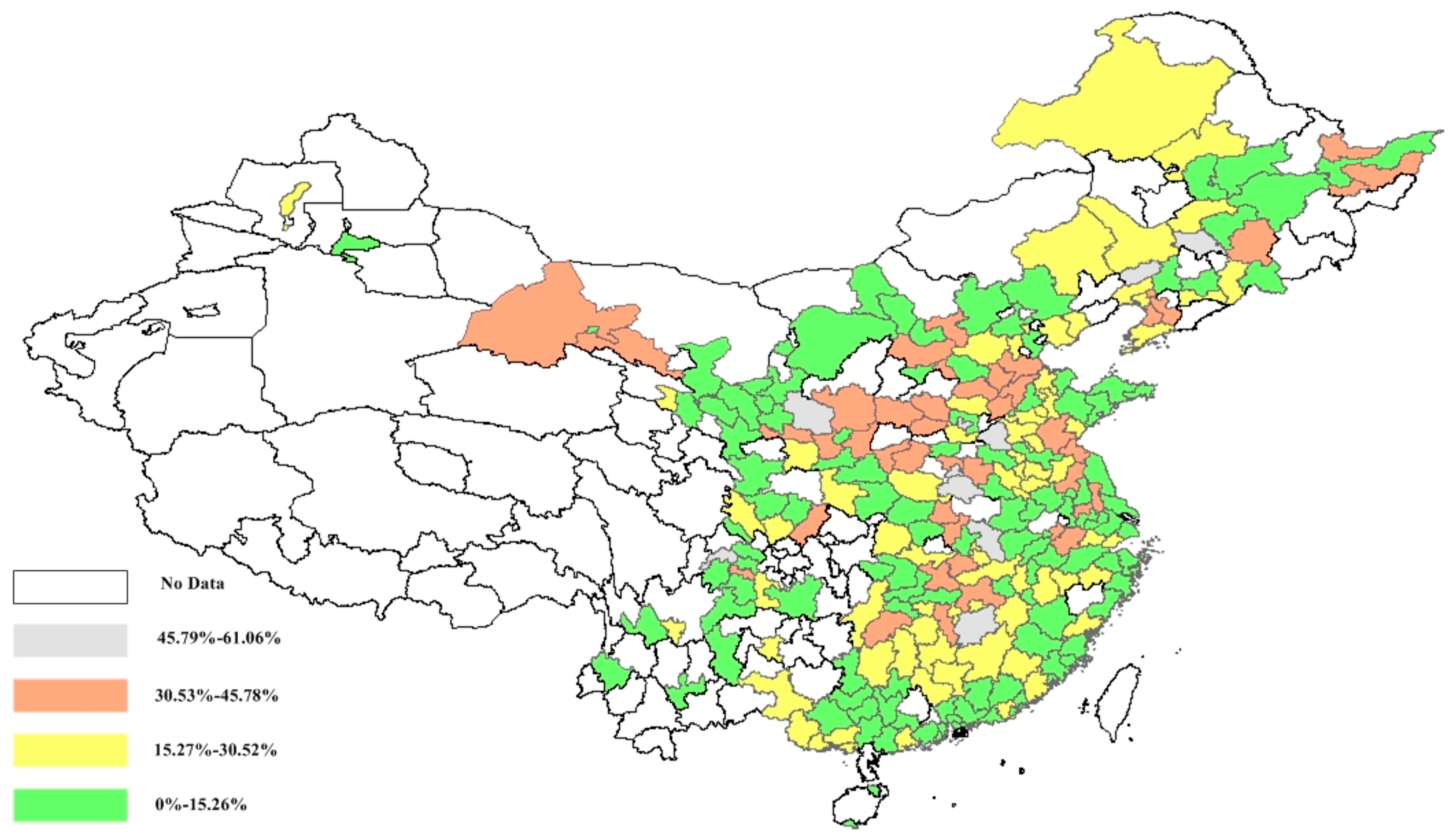
| Factor | Unit | Max | Min | Mean | Std.Dev |
|---|---|---|---|---|---|
| Capital | 108 CNY | 1729.0757 | 2.4504 | 80.290327 | 169.0966 |
| Employee | 104 people | 35,271.782 | 396.6172 | 5054.277 | 5102.978 |
| Energy | 104 TCE 1 | 3155.1309 | 2.496094 | 177.63696 | 333.3128 |
| GDP | 108 CNY | 24,838.37 | 70.2111 | 1560.4235 | 3122.897 |
| PM2.5 | Mcg/m3 | 106.25 | 15.75 | 52.586283 | 17.72751 |
© 2018 by the authors. Licensee MDPI, Basel, Switzerland. This article is an open access article distributed under the terms and conditions of the Creative Commons Attribution (CC BY) license (http://creativecommons.org/licenses/by/4.0/).
Share and Cite
Yu, A.; Jia, G.; You, J.; Zhang, P. Estimation of PM2.5 Concentration Efficiency and Potential Public Mortality Reduction in Urban China. Int. J. Environ. Res. Public Health 2018, 15, 529. https://doi.org/10.3390/ijerph15030529
Yu A, Jia G, You J, Zhang P. Estimation of PM2.5 Concentration Efficiency and Potential Public Mortality Reduction in Urban China. International Journal of Environmental Research and Public Health. 2018; 15(3):529. https://doi.org/10.3390/ijerph15030529
Chicago/Turabian StyleYu, Anyu, Guangshe Jia, Jianxin You, and Puwei Zhang. 2018. "Estimation of PM2.5 Concentration Efficiency and Potential Public Mortality Reduction in Urban China" International Journal of Environmental Research and Public Health 15, no. 3: 529. https://doi.org/10.3390/ijerph15030529





